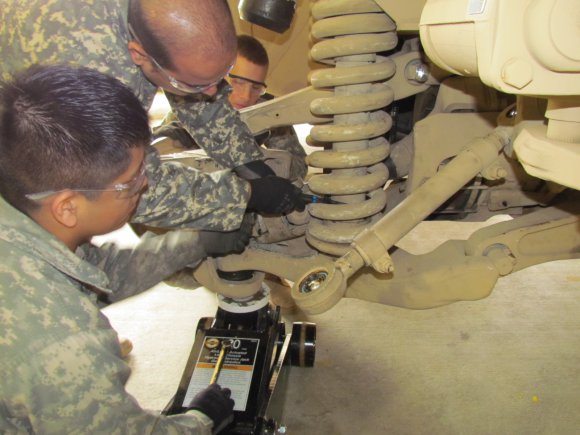Instructors at Fort Jackson’s Wheeled Vehicle Mechanic School decided to use a little imagination to keep valuable equipment from being transferred from the battleground to the classroom.
Rather than treating it as a single problem to be solved, though, instructors decided to seize the opportunity to create interactive, mobile learning tools that improve the way Soldiers are trained as mechanics. These training areas are so specific that any part of the vehicle not contributing to the classroom’s subject area has been eliminated.
In fact, the Independent Suspension System and Automatic Fire Suppression System used in the mine-resistant, ambush-protected vehicle, known as an MRAP, have been fully transplanted into individual mobile teaching tools.
“We took all of the components out of the vehicle and have mounted it on a training aid, and students can troubleshoot it without having the vehicle all around them,” said Chief Warrant Officer 5 Luis Diaz, director of the WVMS. “The instructor will be able to monitor the Soldier’s progress in a computer that will be part of this training aid. The instructor can introduce faults into the system and monitor the progress of students.”
Those tools include training for the Independent Suspension System, or ISS, located beneath the bulky vehicle, and the Automatic Fire Suppression System, or AFSS, which runs in a network through the vehicle’s structure. The ISS still requires students to hoist the tool above the ground, just as they would the actual truck.
“With the suspension system the students don’t have to crawl under the truck,” Diaz said. “We simulate that but we don’t have to jack the whole vehicle up, which saves on time and improves safety.”
It’s also less expensive, said Chief Warrant Officer 4 Gariet Pickering, the site supervisor where suspension system training is conducted.
“We have the complete system that is needed to train the Soldier and it takes up less space,” he said. “It’s portable and easier to move around to a smaller space.”
The AFSS is mounted on racks and allows instructors to create different training scenarios and problems for students to solve.
“If a vehicle downrange encounters an IED (improvised explosive device) the fire suppression system reduces the amount of damage to that vehicle and also creates a higher chance of a Soldier surviving,” said instructor Chief Warrant Officer 3 Roderick Pickett. “The new training tool allows the Soldier to diagnose problems without the cumbersome vehicle. You can get straight to diagnosing what’s keeping that vehicle from working.”
There is also a new training tool that is much less tangible. The Army has developed “virtual vehicles” that can be dismantled piece by piece as part of a software training program. It walks students through exercises both basic and critical, giving them as “real” an experience as possible from a computer exercise.
The digital environments within the program will also look familiar to students. Diaz said the software’s developers photographed the workspace at Fort Jackson for use in the program, even adding local tools from the shops to the virtual environment.
“This is brand new,” he said. “We’ve got it here at Fort Jackson, and Fort Lee has it, too. It looks easy now, but when we were developing this we were sitting around a table trying to figure out what it was supposed to do.”
Maintaining a physical vehicle for instructional use requires additional time, he said, and it isn’t unusual for inexperienced students to damage equipment during training. The virtual tools eliminate both problems, saving time and money.
“When you give a Soldier the chance to do this in a virtual training aid, when the Soldier goes to the actual piece of equipment (he’s) already familiar with it,” Diaz said. “Ninety percent of the Soldiers we see here at Fort Jackson are young and really good with computers. They play a lot of games and this is like a game to them.”
In time, students will be able to take this software with them to the barracks where they can further explore the teaching tools. The program has been in use at the school since 2011, but there have been software conflicts preventing the program from being used on all models of personal computers, Diaz said.

“When we fix all of the glitches we’ve got right now, the students will be able to take that program to the barracks at night and review the lessons,” he said. “When they go back to the site they can perform all these tasks and pass all these tests without problems.”
Pickering said the software might be something including in future graduation packets.
“That way, if they’re out in the field and have a break down and they’ve got their laptop they can put this virtual training disc in, follow directions and make those repairs,” Pickering said. “It’s a valuable asset. I wish I’d had it.”
“If it works out right, a Soldier will be carrying this,” he said, holding up a compact disc, “instead of paper manuals. (Soldiers) can open it up and see the virtual training of any system on the vehicle.”
Pickett said the goal is to modernize the training, facilities and infrastructure at the school.
“We want to meet the millennium generation of mechanics on their level,” Pickett said. “I think we’ve got the tools in place to get to that next level. This is frontier thinking in the schoolhouse.”










